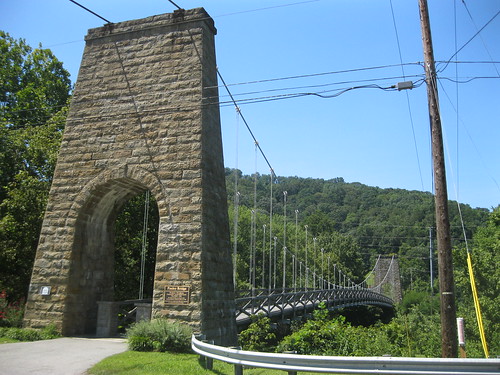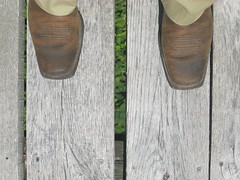 |
| Pauley Bridge - Pikeville, Ky. |
Spanning the Levisa Fork of the Big Sandy River just to the north of Pikeville is the Pauley Bridge. Named for the local community that was annexed by Pikeville in 1990, this suspension bridge has stood since 1936. When it was listed on the National Register in 1992, the Pauley Bridge was still open to vehicular traffic and was one of only four swinging suspension bridges open to vehicular traffic in eastern Kentucky (many others were open to pedestrians only, as Pauley Bridge is today).
Strong cables connect the towers to the banks on either side of the river, while vertical tension hangers connect the main cables to the bridge deck. This swinging suspension bridge design is one of the simplest, and most inexpensive, bridge designs which is why they have been such a popular design. In larger suspension bridges like the Roebling Bridge in Newport, a stiffening truss under the bridge deck strengthens and stabilizes the structure.
The design of this bridge is unique, however, because although the bridge itself is simple - the towers are not. The beautiful rough-cut sandstone towers are impressive. Of the 37 wire suspension bridges proposed by the WPA for construction in southeast Kentucky in the late 1930s, only the design of the Pauley Bridge included these sandstone towers.
 A WPA project begun in 1936, the bridge was completed and opened to traffic in 1940. In 2000, it was closed to vehicular traffic (2001, all traffic) and it quickly acquired the appearance of an abandoned site. But in 2004, the City of Pikeville set aside funds to restore the historic bridge. In 2006, it was reopened as a pedestrian and bicycle bridge.
A WPA project begun in 1936, the bridge was completed and opened to traffic in 1940. In 2000, it was closed to vehicular traffic (2001, all traffic) and it quickly acquired the appearance of an abandoned site. But in 2004, the City of Pikeville set aside funds to restore the historic bridge. In 2006, it was reopened as a pedestrian and bicycle bridge.Above the keystones on either tower are engravings bearing the mark of the 1930s construction project: "WPA" and the year construction began "1936." Thanks to the City of Pikeville, the Pauley Bridge has a new lease on life. More pictures of the Pauley Bridge can be viewed on flickr.
Comments